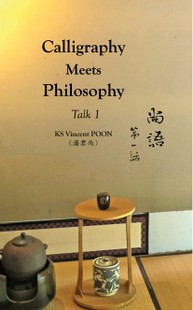The Heart Sutra
(般若波羅蜜多心經)
66 X 35cm in Standard Script (楷書)
The following information is published in the book "Calligraphy Meets Philosophy – Talk 1":

Calligraphy Meets Philosophy - Talk 1 尚語 - 第一話
by KS Vincent POON (Aug. 2022)
ISBN 978-1-989485-30-9
Content is the soul of an artwork.
Thus, catching the soul of Chinese calligraphy requires understanding the literary contents. To facilitate this, the Calligraphy Meets Philosophy series presents traditional Chinese calligraphy alongside line-by-line translated texts with remarks and footnotes.
Calligraphy Meets Philosophy – Talk 1 (《 尚語∙第一話 》) includes three calligraphic works and their translations: Heart Sutra (《般若波羅蜜多心經》), Great Learning (《大學》), and Zhuangzi - The Secret of Caring for Life (《莊子∙養生主》). It also includes Revisions to “An English Translation and the Correct Interpretation of Laozi’s Tao Te Ching”.
WorldCat/Library: [WorldCat] [U of Oxford] [U of Cambridge] [Harvard U] [National Palace Museum Taiwan] [HKU]
On this page, original footnotes and remarks have been removed. Therefore, if you wish to examine the entire work, study the footnotes, cite this work formally, or use this work for any research or educational purpose, please purchase the book or lend it from a library.
Translation
Note: The original Chinese and its sentence arrangement follow the 《 大明太祖高皇帝御製般若心經 ( Heart Sutra: An Imperial Rendition by Emperor Taizu of the Great Ming Empire ) 》(1). Specialized terms in Buddhism are imported from renditions by Edward Conze(2) and the Ven. Dharma Master Lok To (樂渡長老)(3) .
1. 觀自在菩薩,行深般若波羅蜜多時,
When the Bodhisattva Avalokiteśvara (觀自在菩薩)(4) ruminated wisely and deeply (行深)(5) to reach the state of Prajna Paramita (般若波羅蜜多, the Perfection of Transcendent Wisdom),
2. 照見五蘊皆空,度一切苦厄。
He perceived and understood (照見) that all Five Skandhas (五蘊) are of Nothingness (空)(6), and He vowed to transcend all (度一切)(7) to depart all anguishes and sufferings (苦厄).
3. 舍利子,
O Sariputra,
4. 色不異空,空不異色;
Form does not differ from Nothingness, and Nothingness does not differ from Form;
5. 色即是空,空即是色 。
Form is Nothingness, and Nothingness is Form.
6. 受想行識亦復如是。
The same also applies to feelings, perceptions, volitions and consciousness (行識).
7. 舍利子,
O Sariputra,
8. 是諸法空相,不生不滅,
all dharmas (諸法) are marked with the manifestation of Nothingness, they are neither created nor destructible,
9. 不垢不淨,不增不減。
they cannot be defiled nor purified, they cannot be augmented nor diminished.
10. 是故空中, 無色,無受想行識,
Hence, within Nothingness, there is no form, no feeling, no perception, no volition, and no consciousness,
11. 無眼耳鼻舌身意,無色聲香味觸法,
no eye, no ear, no nose, no tongue, no body, no thoughts, no form, no sound, no smell, no taste, no tangible objects, and no objects from thoughts,
12. 無眼界,乃至無意識界。
no realm of the sense of sight and so forth, even to the extent of no realm of consciousness.
13. 無無明,亦無無明盡,
There is no ignorance, and so no annihilation of no ignorance,
14. 乃至無老死,亦無老死盡。
and there is even no decay and death, and so no extinction of decay and death.
15. 無苦集滅道,
There is no suffering and no origin (集) of suffering, and there is no cessation of suffering and no path to the cessation of suffering,
16. 無智亦無得,以無所得故。
there is no wisdom and no attainment of anything whatsoever, for there is nothing to be attained.
17. 菩提薩埵,依般若波羅蜜多故。
The Bodhisattva (菩提薩埵) transcends, for He follows and practises the Prajna Paramita.
18. 心無罣礙,無罣礙故。
He has no hindrance in His mind, for His mind is free of hindrance.
19. 無有恐怖,遠離顚倒夢想,究竟涅槃。
He has no fear, He stays far away from delusional dreams and ultimately reaches the state of Nirvana (涅槃).
20. 三世諸佛,依般若波羅蜜多故,得阿耨多羅三藐三菩提。
The Buddhas of the Past, Present and Future, for they follow and practise the Prajna Paramita, have attained the Supreme Enlightenment (阿耨多羅三藐三菩提).
21. 故知般若波羅蜜多,是大神咒,
Thus, know that the Prajna Paramita (Prajna Paramita Chant) is the Great Divine Spell,
22. 是大明咒,是無上咒,是無等等咒,
the Great Spell of Illumination, the Supreme Spell, and the Unequalled Spell among all,
23. 能除一切苦,眞實不虛故。
which can allay one from all suffering, for it is authentic and not spurious (眞實不虛).
24. 說般若波羅蜜多咒,卽說咒曰:
Hence, if one recites the Prajna Parmita Chant, it is then recited as:
Gate, Gate, Paragate, Parasamgate, Bodhi Svaha.
25. 揭帝揭帝,波羅揭帝,波羅僧揭帝,菩提僧莎訶。
(translated by KS Vincent Poon, Mar. 2017; revised July 2022)
Jump to: Buddhism